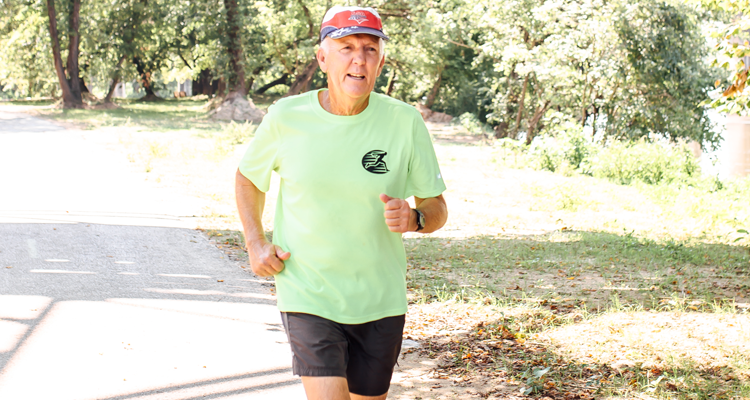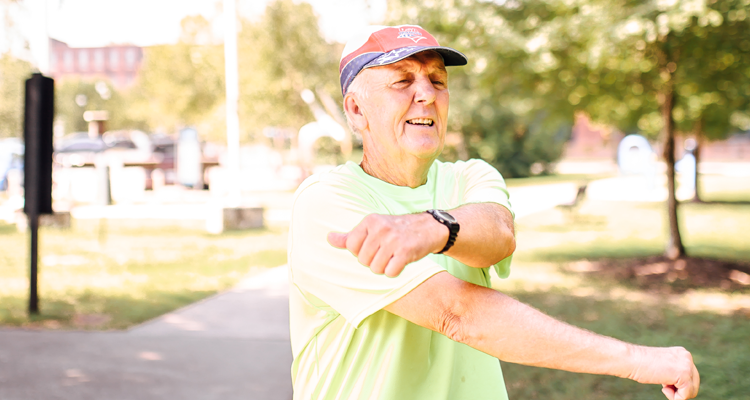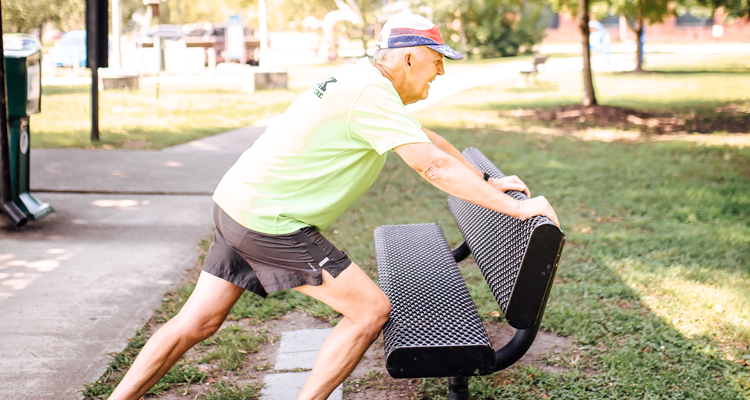We give much thought to planning for financial stability after retirement, but how valuable is being able to take that trip if your body will not allow you to enjoy it?
How do you see your life after retirement? Do you want to travel? Do you want to take the grandkids for walks in the park? Is your current lifestyle conducive to those plans? Most people assume their bodies will cooperate with an active retirement lifestyle. But if you’re not caring for every aspect of your health, that may not be the case. Take a snapshot of your life to this point. Are you significantly heavier than you were years ago? Have your nagging aches and pains become more of a hindrance? Do you give out of breath when you tackle a flight of stairs? If the answer is yes, that climb will be steeper and much harder as you age — unless you attempt to change now.
A good health portfolio starts with the basics. There are no quick remedies. Start by concentrating on the bad habits that are adversely affecting your health.
If You Smoke… Stop – the life-altering effects of smoking are no secret. Ending your nicotine habit can have more of a positive influence on retirement years than any other change.
Dissect Your Diet – keep a food journal. Limit high-calorie, high-fat, and high-salt foods. Focus more on vegetables, fruits, whole grains, and lean meat. Practice portion control.
Maintain a Healthy Weight – roughly two-thirds of American adults are overweight. Being overweight puts you at risk for preventable diseases such as heart conditions, cancer, and diabetes. Carrying extra weight also puts a load on your joints. Find your healthy weight and BMI and strive to reach it.
Keep an Eye on Your Blood Pressure – One of the most important things that improve long-term health is to maintain normal blood pressure. The Center for Science of Public Interest states that by the age of 60, 60 percent of Americans have alarmingly high blood pressure that needs to be medically treated. Millions more of adults with elevated blood pressure are at an increased risk of heart attack and stroke.
Watch Your Cholesterol – Those with high LDL (bad) cholesterol are prime candidates for heart disease. For middle-aged people, a drop of 1 percent in LDL cholesterol lowers the risk of heart disease by 2 or 3 percent. Losing weight and regular exercise help to reduce cholesterol.
Monitor Your Blood Sugar – Have your fasting blood sugar level tested at least once a year. If the test suggests an abnormality, work alongside your physician to correct your lifestyle.
Relax – Stress can wreak havoc on you physically and emotionally. Side effects of stress are depression, increased heart rate, higher blood pressure, and overeating. Relaxation is a natural way to combat stress. Practice mediation, deep breathing, soothing music, or get lost in a book.
Don’t Skip the Annual Physical – An annual physical is the first line of prevention. As medicine has evolved, tests can now spot health problems early and corrective treatment measures can be taken.

Age isn’t the enemy
The human body is a wonder of science. Aging gracefully isn’t an anomaly, but the body can’t be taken for granted. Maintaining a well-balanced diet should be a priority. Healthy eating helps to combat preventable diseases such as high blood pressure and Type 2 diabetes, as well as heart disease. When grocery shopping, be sure to grab some colorful fruits and vegetables which are high in nutrients and low in calories. Protein is something else that should be on the list. Protein deficiencies in seniors are rising. Without adequate protein, the immune system and muscles are negatively affected. Also, be sure to always stay hydrated. Dehydration is common in older adults due to medications, diseases, and a decreased feeling of thirst.
Count your calories and understand that not all calories are created equally. Be aware of empty calories, such as those found in soft drinks and avoid them. According to the National Institute women who are over 50 and are very active need an average of 2,000 calories a day. That number drops to 1800 for those who a somewhat physically active and to 1600 for women who aren’t physically active. For men over 50 and very active, the number is between 2400 and 2800 calories a day. For those somewhat physically active it drops to 2200 to 2400 and for those not physically active, the number is 2000 calories a day.
As we age, our skin thins and becomes more susceptible to bruises and cuts. Healing times are also longer. Protecting your skin is imperative. This includes from the sun. Wear a bucket hat, sunglasses, and plenty of sunscreen when you’re enjoying an afternoon stroll on the Riverwalk.
Research from the National Council of Aging states that one in four Americans over the age of 65 fall each year. Prevent falls by eliminating throw rugs and loose carpet. Keep clear pathways, free of anything that can trip you up — electrical cords and general clutter. Line the hallways and bathrooms with nightlights. Wearing shoes with proper support can also help. A study for Footwear Science monitored elderly participants noting the type of footwear they usually wore and followed them for 27 months. Eighteen percent of those who suffered a fall were barefoot when they fell, 27 percent fell in slippers, and 7 percent fell while wearing socks.

And don’t fall for scams
Falling prey to a scam increases as technology evolves. Savvy criminals are on the cusp of “the next big thing” mapping out ways to use it to their advantage. Let’s face it — no one is immune to scams, but thieves look at older adults as “easy pickings.” There are many factors that make senior citizens more desirable to scammers, everything from their polite nature to excellent credit scores. A major attraction for criminals is that older adults are less likely to report being scammed due to embarrassment or lack of knowledge on where to report the crime.
There is nothing to be ashamed about if you fall victim to a scam. In 2018, The Federal Trade Commission received more than 1.4 million fraud reports that led to people reporting a loss of 1.48 BILLION dollars which was a 38 percent increase over 2017. Being aware of the latest scams and tactics can ensure you’re not an easy target for criminals.
Mail theft is one of the easiest ways for criminals to target you. It’s not hard to combat though, have any checks that you receive — social security, stock dividends, pensions, disability — directly deposited into your checking or savings account.
Telemarketing is another main avenue for criminals. Protect yourself by signing up for the “Do Not Call” registry by calling 1-888-382-1222 or at https://www.donotcall.gov/. This will not stop all calls, so be aware that any call that claims you’ve won a cruise, car, security system, or even something as simple as a walking cane is a potential scam. Do not agree to anything and do not give out any personal information over the phone.
Scammers target potential victims through direct mail using the same nefarious tactics. If you receive mail that informs you that you’ve won anything, read the fine print. If they are asking for any financial contribution from you, you didn’t win. But if you feel the offer is legitimate, get a second opinion before agreeing to anything.
The threat of scams will always be there. Being proactive will shield you from risks, but if you fall victim to a scam, don’t remain silent. Talk to someone you trust and contact the proper authorities. Doing nothing is the worst thing you can do, and it opens you up to future attacks.
The importance of staying active
A good portion of Americans spend too much time inactive — whether it be at a desk job or at home surfing the Net and watching television. A sedentary lifestyle can be detrimental to long-term health.
Regular exercise that incorporates aerobic and strength training comes with a wide array of benefits — improved cardiovascular health, weight control, stress relief, muscle and joint strengthening to name a few. Developing an exercise routine and sticking to it can stave off aches and pains and increase strength and mobility as we age.
In order to be successful, ease into exercise. If you’re not accustomed to being active, the shock may be too much for your body… at first. Walk before you run. And discuss your exercise goals with your physician.
Your health is better than any excuse not to exercise. If you’re having a hard time getting, or staying motivated, partner up. Having an exercise buddy who relies on you will serve as motivation to not let them down and to push you to become serious about getting active.

Go see the doctor
An annual physical is crucial to maintaining optimal health as we age, but don’t neglect other screenings and exams. A yearly dental exam and screening is recommended for a healthy mouth. It’s also important to schedule a comprehensive eye exam every two years. Sooner if you’re experiencing changes in vision. For men, don’t forget to screen for prostate abnormalities such as cancer. Women should have a complete breast exam every year. If you’re over the age of 65, talk to your primary care physician about an osteoporosis screening.
There are many other recommended screenings. Talk to your primary care physician to develop a plan that’s right for you based on your family history and current health.
A good health portfolio can strengthen your financial portfolio
Today, some companies are limiting health coverage for future retirees. Some are doing away with the coverage all together. If this affects you and you retire before age 65, you’ll need to shop for an individual health insurance policy.
A major factor that affects the policy price is an individual’s medical history. A healthier person will be more likely to qualify for lower costs.
Healthy people tend to have fewer health problems; this will help with costs such as co-payments and deductibles.









